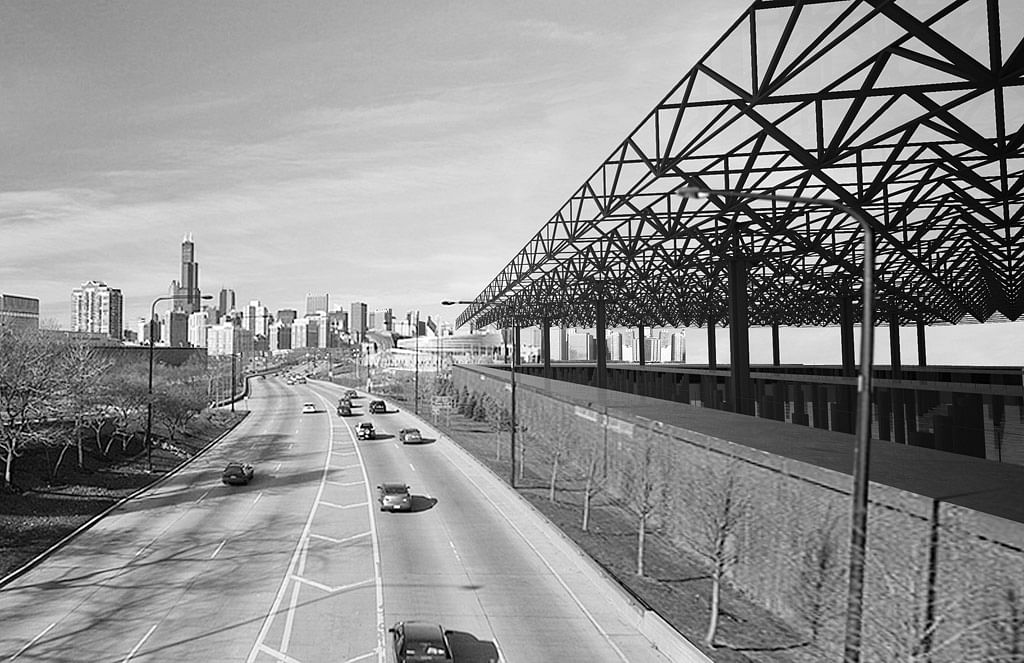Winner of the 2011 Burnham Prize Competition "McCormick Place REDUX"
By Bustler Editors|
Monday, May 2, 2011

Related
Three winners and seven Honorable Mentions were recently announced for the 2011 Burnham Prize Competition “McCormick Place REDUX”.
Hosted by the Chicago Architectural Club and co-sponsored by the Chicago chapter of the American Institute of Architects and Landmarks Illinois, this year’s competition is intended to examine the controversial origins and questionable future of the McCormick Place East Building, the 1971 modernist convention hall designed by Gene Summers of C.F. Murphy Associates and sited along the lakefront in Chicago's Burnham Park.
From the competition brief: "Built on land meant to be “forever open, clear, and free”, considered obsolete by its owners, and an eyesore by open space advocates, Summer’s design for McCormick Place East is nevertheless a powerfully elegant exploration of some of modernism’s deepest concerns. What alternate role might the building play in Chicago should it be decommissioned as a convention hall? What might you do with nearly a million square feet of space (and the 4,200 seat Arie Crown theatre) on the lakefront?"
The Jury awarded the First Prize to the proposal "(Toward) a Requiem" by Mohamed Sharif, Felix Monasakanian, Efren Soriano, and Teo Biocina from Los Angeles; the Second Prize to Srdan Nad from Ljubljana, Slovenia; and the Third Prize to PATH, Matt Hutchinson and Brandon Pace.
Below is the First Prize-winning entry "(Toward) a Requiem":
Project Description from the Architects:
Undeservedly unsung since its unveiling, its perimeter and profile crowded with the bloated mediocrity of the ex-urban landscape of late Capitalism, this great hall longs for an elegant and graceful end. Therefore we propose the transformation of McCormick Place into a dignified ruin of the American Century. Its renewal will be its final act, the building becoming an open air, water-filled hypostyle hall with a theater whose roof is the sky glimpsed through the precise structural frame.

The primary organizational strategy is subtractive, comprising a reduction of the building to an open frame. This entails (once more) a careful adaptation of the artificial shoreline and the east edge of the plinth to form an inlet for lake water to flow into the building. The roof cover is removed inviting the sky to pour into the building. Disassembly of the floor plates creates two bridges and three voids in the great hall and the columns on the lower floors are brought into the light of day. The bridges link the north edge of the building and the ante-space to the north of the Arie Crown Theater. Each bridge overlooks the central void, which is emptied of all columns to create a vast, serene reflecting pool. To the east and west the bridges overlook column filled voids, each forming a lake water pool with a specific restless quality. The west void is bounded at the edge by the plinth wall. It is a noisy, murky underworld. The east edge of the eastern pool is marked by the beat of the column intervals framing views to the island and the distant eastern horizon.

Perhaps people will come to swim here and perhaps some will dock their boats. Perhaps new kinds of theater will be performed here and perhaps one autumn morning we will see on the unfathomable inkiness of the ancient great water the exacting lines of civilization trembling on the vast aqueous meniscus. We will be among it and it among us.
On reflection perhaps Summers, the collegiate swimmer, had shared his Aachen-born mentor’s deep fascination with the mesmerizing interplay between architecture and water, between perfection and the disconcerting double of its reflection. From Barcelona to the Illinois flood plains, Mies, repeatedly devised subtly turbulent threshold conditions in his juxtapositions of the stable repose of a frame with flickering water nearby.
Images courtesy of Mohamed Sharif.

Share
0 Comments
Comment as :